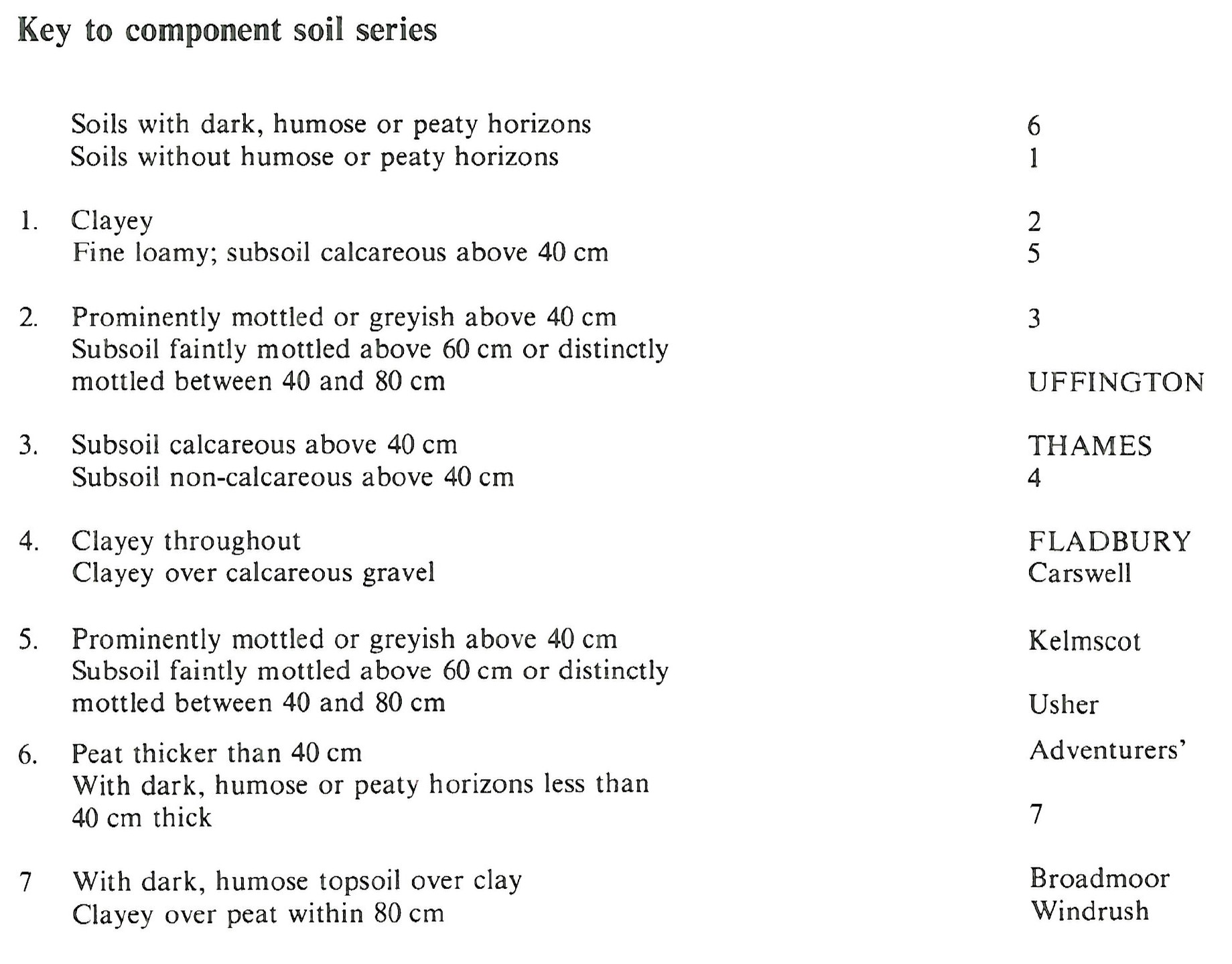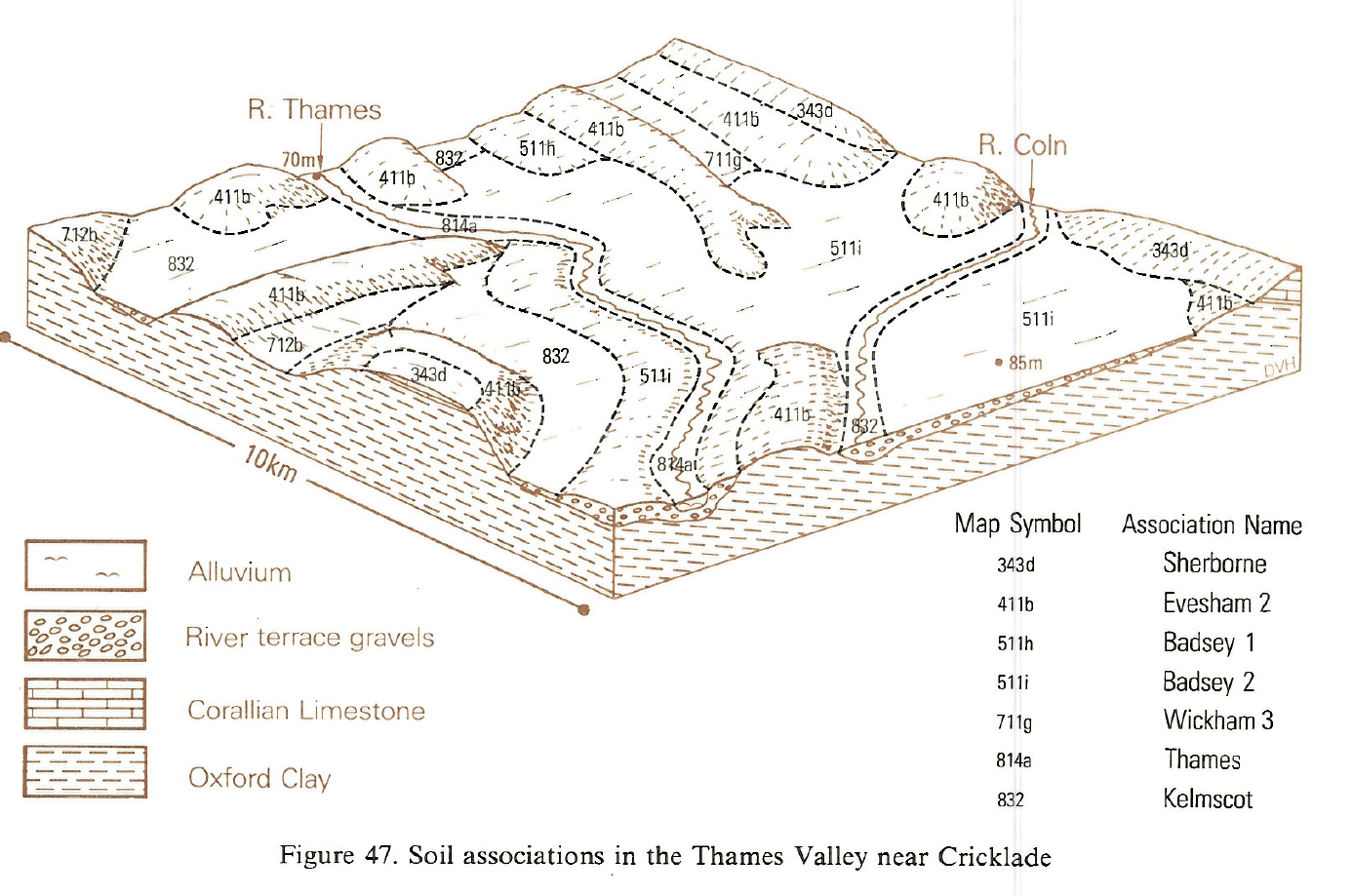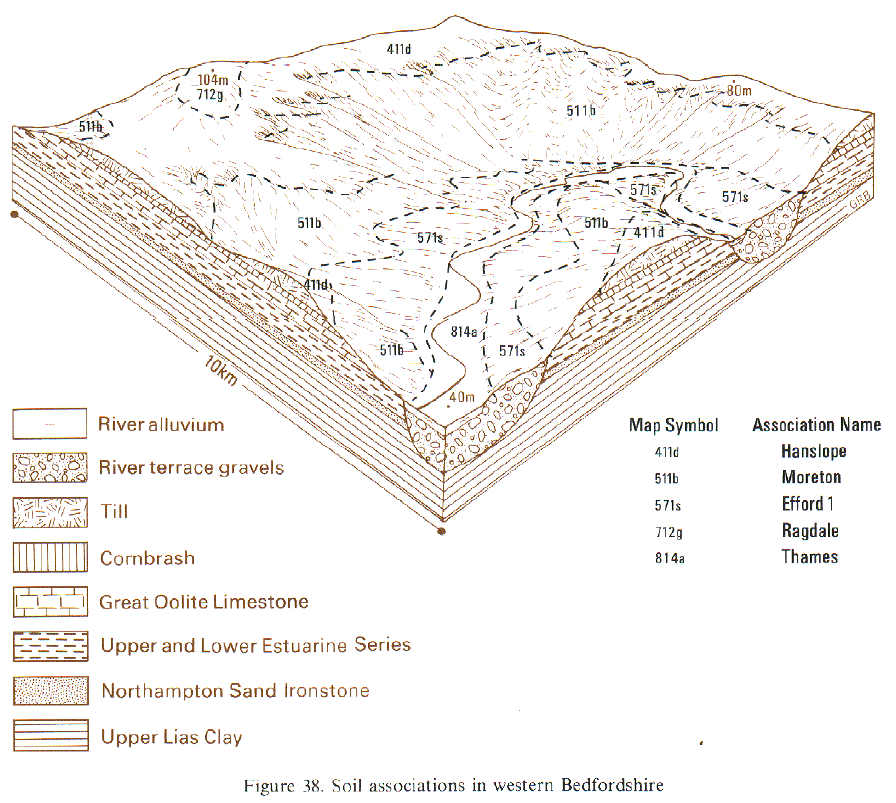
Soil Associations
0814a THAMES
Soil and site characteristics
Stoneless mainly calcareous clayey soils affected by groundwater. Flat land. Risk of flooding.
Geology
River alluvium
Cropping and Land Use
Permanent grassland in moist districts some cereals elsewhere.
Component soil series
| Subgroup | Series name | Percentage | WRB 2006 link |
|---|---|---|---|
| 8.14 | THAMES | 70% | Clayic Fluvic Calcaric Gleysols |
| 8.13 | FLADBURY | 12% | Clayic Fluvic Eutric Gleysols |
| 5.33 | UFFINGTON | 8% | Fluvic Clayic Calcaric Endogleyic Cambisols |
Covers 269 km2 in England and Wales
Soilscapes Classification
| 20 |
Loamy and clayey floodplain soils with naturally high groundwater |
0814a THAMES
Detailed Description
Thames association consists mainly of grey calcareous clayey soils in river alluvium affected by groundwater and occasional flooding. The soils are found on the floodplains of rivers draining calcareous Jurassic and Cretaceous rocks, chiefly the Thames and its tributaries. There are small areas in the South West, the South East, the Midlands and in Eastern England. The calcareous pelo-alluvial gley soils of the Thames series have much ochreous mottling throughout the profile and similar, but non-calcareous, pelo-alluvial gley soils of the Fladbury series occur locally in most valleys. Other soils are characteristic of some valleys but are absent in others. These include the less mottled pelogleyic brown calcareous alluvial soils of the Uffington series and the similar fine loamy Usher series on levees a little above the floodplain where they are less influenced by groundwater, as well as the Carswell and Kelmscot soils in grey clay or loam over limestone gravel. Broadmoor soils with a thick humose topsoil over grey clay, Windrush soils in grey clay over peat and patches of Adventurers' series in amorphous peat tend to occur in the lowest wettest sites, such as abandoned meanders, in-filled lakes, and old water-meadow ditches. Brief descriptions of the main soils are given below.
These soils are found mostly in the Great Ouse valley above St Neots. Small areas also occur in the Cam, Granta and Rhee valleys above Cambridge, in the Stort, Ash, Beane, Mimram and upper Lea valleys in Hertfordshire, and in the Stour and Lark valleys in Suffolk. Thames soils are commonly calcareous in upper horizons only and the soils merge locally and downstream with non-calcareous Fladbury series. Windrush soils occur locally where peat is covered by calcareous alluvial clay.
In north Wiltshire, along the Thames west of Lechlade, Thames soils occupy the narrow central part of the floodplains of the main river and its south bank tributaries. Uffington soils are found on levees and embankments, and Kelmscot and Carswell soils occur on patches of floodplain terrace gravel. In the Vale of Pewsey, the association includes some Adventurers' and Windrush soils in peat and clay over peat. South west of Sherborne, along the Yeo, there are ancilliary Carswell, Fladbury and Uffington soils.
The association occurs along the Thames and its tributaries the Windrush, Thame, Kennet and Colne. Thames series is dominant, with Fladbury series common near to junctions with the Thame and Cherwell. Below Marlow, on Chertsey Mead and around Richmond, Usher soils form low islands above the floodplain; elsewhere Usher and Uffington soils are confined to narrow levees. In the Thames valley between Kelmscot and Marlow, and in the lower Kennet valley there are small areas of Carswell and Broadmoor series and clayey or peaty soils with gravelly or silty subsoils. Soils over gravel or peat and patches of peat soils are common in the Colne valley north of Uxbridge. The association also occurs in the Meon valley in Hampshire between East Meon and Soberton. Here Thames series dominates with some silty Wittering and humose Broadmoor soils, and Uffington and Gade soils in upper reaches.
Soil Water Regime
Most of these soils are affected by groundwater and flooding. Depending on outfalls and field drainage measures, waterlogging may be confined to winter, or extend into the growing season (Wetness Classes III or IV) but, because the land is flat and near to river level, the soils are often difficult to drain effectively. Along the Thames, where river levels are controlled, the soils lie wet above the weirs but are relatively dry below. The soils are moderately droughty for grass and slightly droughty for cereals.
Cropping and Land Use
Even where drainage is effective, grazing locally remains restricted because of the risk of poaching. Where flooding has been limited by embankments and the land drained effectively cereals are grown, but the land often remains difficult to manage because of the clayey texture and patches of wet soil with low bearing strength.
Some unimproved meadows along the Thames in Oxfordshire are managed to retain their diverse flora. Pixey and Yarnton Meads arc regularly cut for hay and there, meadow foxtail (Alopecurus pratensis), sweet vernal-grass (Anthoxanthum odoratum) and red fescue (Festuca rubra)are accompanied by early maturing herbs like great burnet (Sanguisorba officinalis). Port Meadow is grazed and its wetter parts have flote-grass (Glyceriafluitans), rough-stalked meadow-grass (Poa trivialis), common spike-rush (Eleocharis palustris) and water dropwort (Oenanthe fistulosa).
0814a THAMES
Distribution Map
 |
Note that the yellow shading represents a buffer to highlight the location of very small areas of the association.
Keys to component soil series
South Eastern Region
 |
Eastern Region
 |
Typical Landscapes
South Western Region
 |
Eastern Region
 |
South Eastern Region
 |
All information Copyright, Cranfield University © 2025
Citation: To use information from this web resource in your work, please cite this as follows:
Cranfield University 2025. The Soils Guide. Available: www.landis.org.uk. Cranfield University, UK. Last accessed 25/04/2025
